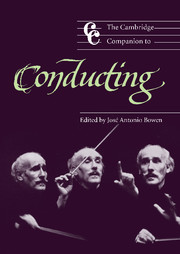Book contents
16 - Women on the podium
from Part III - Issues
Published online by Cambridge University Press: 28 September 2011
Summary
The orchestral conductor stands elevated on a podium commanding the most prestigious musical organization in Western culture. As Elias Canetti observed, “there is no more obvious expression of power than the performance of a conductor.” This display of power conflicts with traditional views of women and may explain why conducting remains “the last male bastion” in musical life.
Like the gendering of genius, the “maestro myth” is male. Jorge Mester, a conducting teacher at Juilliard when JoAnn Falletta became the first woman to earn a doctorate in orchestral conducting there in 1989, identified “forceful personality and charisma” as key elements, in addition to skill, for a major career. These traits are conventionally identified with men and put women conductors in a double bind. Andrea Quinn notes that women conductors “need to get results by persuasion. It's pointless trying to throw your weight around. Coming from a man, that can be seen as authoritative. From a woman, it's just considered bossy.” Despite a host of obstacles, however, women have long been conductors.
Early women conductors
The earliest description of a baton conductor (in 1594) is of a woman, though like many early-twentieth-century women conductors, “the Maestra” at the convent in San Vito in Ferrara leads an all-women ensemble. Fanny Mendelssohn Hensel (1805–47) conducted a mixed ensemble of men and women, but only in a private setting. Hensel began conducting her own large choral-orchestral works at private salons (Sonntagsmusik) in the early 1830s while her brother Felix developed a public conducting career.
- Type
- Chapter
- Information
- The Cambridge Companion to Conducting , pp. 220 - 236Publisher: Cambridge University PressPrint publication year: 2003
- 1
- Cited by



